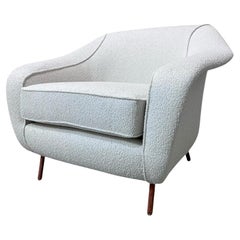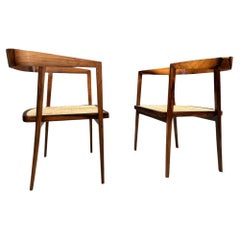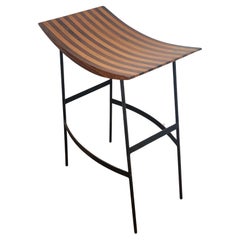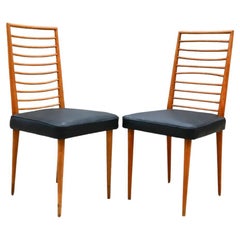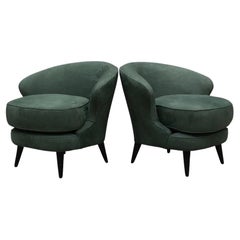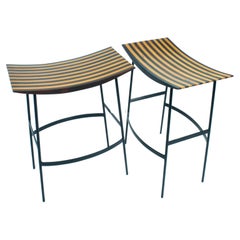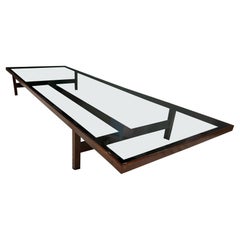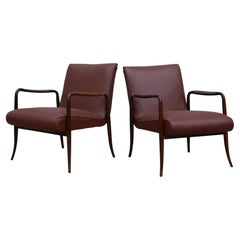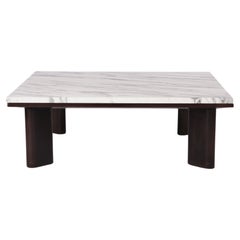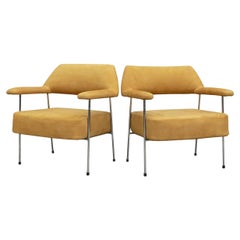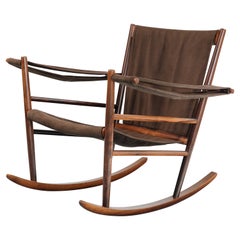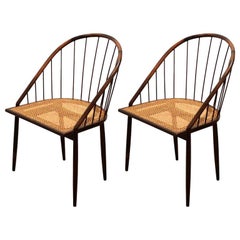Joaquim Tenreiro On Sale
Vintage 1940s Brazilian Mid-Century Modern Armchairs
Leather, Hardwood
Mid-20th Century Brazilian Mid-Century Modern Armchairs
Metal
Mid-20th Century Brazilian Mid-Century Modern Armchairs
Hardwood, Cane
Vintage 1950s Brazilian Mid-Century Modern Stools
Hardwood
Mid-20th Century Brazilian Mid-Century Modern Chairs
Leather, Hardwood
Mid-20th Century Brazilian Mid-Century Modern Armchairs
Hardwood, Suede
Mid-20th Century Brazilian Mid-Century Modern Stools
Iron
Mid-20th Century Brazilian Mid-Century Modern Coffee and Cocktail Tables
Glass, Hardwood
Mid-20th Century Brazilian Mid-Century Modern Armchairs
Leather, Hardwood
Vintage 1950s Brazilian Mid-Century Modern Coffee and Cocktail Tables
Marble
Mid-20th Century Brazilian Mid-Century Modern Armchairs
Metal
Vintage 1950s Brazilian Mid-Century Modern Armchairs
Fabric, Wood
Vintage 1950s Brazilian Mid-Century Modern Armchairs
Fabric, Wood
Mid-20th Century Brazilian Mid-Century Modern Armchairs
Upholstery, Wood
Vintage 1960s Brazilian Mid-Century Modern Desks
Hardwood
Mid-20th Century Brazilian Mid-Century Modern Chairs
Leather, Cane, Hardwood
Mid-20th Century Brazilian Mid-Century Modern Sofas
Velvet, Hardwood
Mid-20th Century Brazilian Mid-Century Modern Armchairs
Hardwood, Ultrasuede
Mid-20th Century Brazilian Mid-Century Modern Dining Room Chairs
Iron
Mid-20th Century Brazilian Mid-Century Modern Armchairs
Leather, Hardwood, Ebony
Vintage 1960s Brazilian Mid-Century Modern Chairs
Fabric, Wood, Plywood
Vintage 1950s Brazilian Mid-Century Modern Armchairs
Linen, Hardwood
Vintage 1960s Brazilian Mid-Century Modern Chairs
Wood, Cane
Recent Sales
Mid-20th Century Brazilian Mid-Century Modern Rocking Chairs
Rosewood
Vintage 1960s Brazilian Mid-Century Modern Chairs
Cane, Hardwood
Vintage 1940s Brazilian Mid-Century Modern Armchairs
Leather, Wood
Mid-20th Century Brazilian Mid-Century Modern Chairs
Cane, Wood
Vintage 1960s Brazilian Mid-Century Modern Abstract Sculptures
Iron
Vintage 1950s Brazilian Mid-Century Modern Lounge Chairs
Fabric, Wool
Mid-20th Century Brazilian Mid-Century Modern Dining Room Chairs
Straw, Hardwood
Vintage 1960s Brazilian Mid-Century Modern Desks and Writing Tables
Rosewood
1990s Brazilian More Desk Accessories
Paper
Vintage 1970s Brazilian Mid-Century Modern End Tables
Rosewood
People Also Browsed
Mid-20th Century Brazilian Mid-Century Modern Sofas
Suede, Fiberglass
2010s Mexican Brutalist Contemporary Art
Wood
2010s Oceanic Organic Modern Ottomans and Poufs
Fabric, Foam
21st Century and Contemporary American Mid-Century Modern Flush Mount
Brass, Silver, Gold, Steel
21st Century and Contemporary Italian Modern Sofas
Metal
2010s American Minimalist Benches
Fiberglass
Vintage 1970s Italian Beds and Bed Frames
Metal
Vintage 1970s Italian Post-Modern Beds and Bed Frames
Leather, Wood
Mid-20th Century Italian Mid-Century Modern Lounge Chairs
Brass
21st Century and Contemporary German Mid-Century Modern Chandeliers and ...
Brass
2010s Table Lamps
Iron
2010s Italian Mid-Century Modern Wall Lights and Sconces
Brass
20th Century French Mid-Century Modern Stools
Wood, Pine
2010s Austrian Jugendstil Chandeliers and Pendants
Silk
Vintage 1970s Italian Mid-Century Modern Sofas
Velvet
Vintage 1970s Mid-Century Modern Chairs
Paper
Joaquim Tenreiro On Sale For Sale on 1stDibs
How Much is a Joaquim Tenreiro On Sale?
Joaquim Tenreiro for sale on 1stDibs
The Portugese-born furniture designer Joaquim Tenreiro was a pioneer of modernism in Brazil, where his work paved the way for the successes of such mid-20th-century design greats as Sergio Rodrigues, Jorge Zalszupin, and Lina Bo Bardi, an Italian-Brazilian architect whose futuristic São Paulo buildings are only part of her legacy.
Tenreiro’s vintage tables, chairs and storage cabinets are known for their simplicity of line and an elegance that is enhanced by the use of richly grained South American hardwoods such as jacaranda and imbuia.
Tenreiro’s father and grandfather were both master woodworkers, under whom he trained in the craft. He had artistic leanings and in the late 1920s enrolled as a university student at the School of Arts and Crafts in Rio de Janeiro, where he joined a group of upstart modernists protesting the staid, retrograde curriculum at the college. At the time, Brazil was culturally mired in a 19th-century mindset that was reflected in an upper-class preference for academic painting and reproduction furnishings in antique European styles. But the progressive spirit that Tenreiro and his colleagues fostered slowly gained force.
With the terms “lightness” and “functionality” as his bywords, Tenreiro opened a furniture-design business in 1943, where one of his first clients was the legendary architect Oscar Niemeyer. The arrival of Brazil’s first democratically elected government, in 1945, lent modernism official sanction, which culminated in the construction of the new capital, Brasília. Tenreiro eventually stepped away from design in the late 1960s to devote his time to sculpture and painting.
To appreciate how revolutionary Tenreiro’s work seemed, one must imagine the heavy, ornately carved, deeply varnished furniture that was the standard for top-end Brazilian interior design in the 1930s. Tenreiro’s chairs and sofas employed slender, softly angular frames that were only lightly stained to highlight the grains of the local woods. He preferred chairs and chaises with caned seats and backrests that “breathe” in the tropical climate, and as a carpenter and joiner he wanted to show off the beauty of Brazilian wood.
Two versions of a three-legged side chair introduced in 1947 serve as a veritable manifesto for a new age in Brazilian design: Using the stack-lamination technique, Tenreiro bonded together a gently contoured seat made of alternating layers of different-colored native woods to produce a magnificent stripe effect. These chairs, like all Tenreiro works, demonstrate the enduring power of simple design and superb construction — with a teaspoon of flair.
Find vintage Joaquim Tenreiro furniture on 1stDibs.
A Close Look at Mid-century Modern Furniture
Organically shaped, clean-lined and elegantly simple are three terms that well describe vintage mid-century modern furniture. The style, which emerged primarily in the years following World War II, is characterized by pieces that were conceived and made in an energetic, optimistic spirit by creators who believed that good design was an essential part of good living.
ORIGINS OF MID-CENTURY MODERN FURNITURE DESIGN
- Emerged during the mid-20th century
- Informed by European modernism, Bauhaus, International style, Scandinavian modernism and Frank Lloyd Wright’s architecture
- A heyday of innovation in postwar America
- Experimentation with new ideas, new materials and new forms flourished in Scandinavia, Italy, the former Czechoslovakia and elsewhere in Europe
CHARACTERISTICS OF MID-CENTURY MODERN FURNITURE DESIGN
- Simplicity, organic forms, clean lines
- A blend of neutral and bold Pop art colors
- Use of natural and man-made materials — alluring woods such as teak, rosewood and oak; steel, fiberglass and molded plywood
- Light-filled spaces with colorful upholstery
- Glass walls and an emphasis on the outdoors
- Promotion of functionality
MID-CENTURY MODERN FURNITURE DESIGNERS TO KNOW
- Charles and Ray Eames
- Eero Saarinen
- Milo Baughman
- Florence Knoll
- Harry Bertoia
- Isamu Noguchi
- George Nelson
- Danish modernists Hans Wegner and Arne Jacobsen, whose emphasis on natural materials and craftsmanship influenced American designers and vice versa
ICONIC MID-CENTURY MODERN FURNITURE DESIGNS
- Eames lounge chair
- Nelson daybed
- Florence Knoll sofa
- Egg chair
- Womb chair
- Noguchi coffee table
- Barcelona chair
VINTAGE MID-CENTURY MODERN FURNITURE ON 1STDIBS
The mid-century modern era saw leagues of postwar American architects and designers animated by new ideas and new technology. The lean, functionalist International-style architecture of Le Corbusier and Bauhaus eminences Ludwig Mies van der Rohe and Walter Gropius had been promoted in the United States during the 1930s by Philip Johnson and others. New building techniques, such as “post-and-beam” construction, allowed the International-style schemes to be realized on a small scale in open-plan houses with long walls of glass.
Materials developed for wartime use became available for domestic goods and were incorporated into mid-century modern furniture designs. Charles and Ray Eames and Eero Saarinen, who had experimented extensively with molded plywood, eagerly embraced fiberglass for pieces such as the La Chaise and the Womb chair, respectively.
Architect, writer and designer George Nelson created with his team shades for the Bubble lamp using a new translucent polymer skin and, as design director at Herman Miller, recruited the Eameses, Alexander Girard and others for projects at the legendary Michigan furniture manufacturer.
Harry Bertoia and Isamu Noguchi devised chairs and tables built of wire mesh and wire struts. Materials were repurposed too: The Danish-born designer Jens Risom created a line of chairs using surplus parachute straps for webbed seats and backrests.
The Risom lounge chair was among the first pieces of furniture commissioned and produced by celebrated manufacturer Knoll, a chief influencer in the rise of modern design in the United States, thanks to the work of Florence Knoll, the pioneering architect and designer who made the firm a leader in its field. The seating that Knoll created for office spaces — as well as pieces designed by Florence initially for commercial clients — soon became desirable for the home.
As the demand for casual, uncluttered furnishings grew, more mid-century furniture designers caught the spirit.
Classically oriented creators such as Edward Wormley, house designer for Dunbar Inc., offered such pieces as the sinuous Listen to Me chaise; the British expatriate T.H. Robsjohn-Gibbings switched gears, creating items such as the tiered, biomorphic Mesa table. There were Young Turks such as Paul McCobb, who designed holistic groups of sleek, blond wood furniture, and Milo Baughman, who espoused a West Coast aesthetic in minimalist teak dining tables and lushly upholstered chairs and sofas with angular steel frames.
Generations turn over, and mid-century modern remains arguably the most popular style going. As the collection of vintage mid-century modern chairs, dressers, coffee tables and other furniture for the living room, dining room, bedroom and elsewhere on 1stDibs demonstrates, this period saw one of the most delightful and dramatic flowerings of creativity in design history.
On the Origins of Brazil
More often than not, vintage mid-century Brazilian furniture designs, with their gleaming wood, soft leathers and inviting shapes, share a sensuous, unique quality that distinguishes them from the more rectilinear output of American and Scandinavian makers of the same era.
Commencing in the 1940s and '50s, a group of architects and designers transformed the local cultural landscape in Brazil, merging the modernist vernacular popular in Europe and the United States with the South American country's traditional techniques and indigenous materials.
Key mid-century influencers on Brazilian furniture design include natives Oscar Niemeyer, Sergio Rodrigues and José Zanine Caldas as well as such European immigrants as Joaquim Tenreiro, Jean Gillon and Jorge Zalszupin. These creators frequently collaborated; for instance, Niemeyer, an internationally acclaimed architect, commissioned many of them to furnish his residential and institutional buildings.
The popularity of Brazilian modern furniture has made household names of these designers and other greats. Their particular brand of modernism is characterized by an émigré point of view (some were Lithuanian, German, Polish, Ukrainian, Portuguese, and Italian), a preference for highly figured indigenous Brazilian woods, a reverence for nature as an inspiration and an atelier or small-production mentality.
Hallmarks of Brazilian mid-century design include smooth, sculptural forms and the use of native woods like rosewood, jacaranda and pequi. The work of designers today exhibits many of the same qualities, though with a marked interest in exploring new materials (witness the Campana Brothers' stuffed-animal chairs) and an emphasis on looking inward rather than to other countries for inspiration.
Find a collection of vintage Brazilian furniture on 1stDibs that includes chairs, sofas, tables and more.

